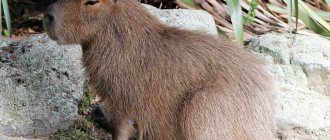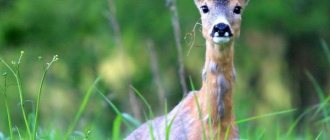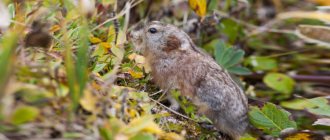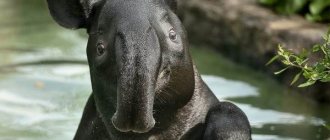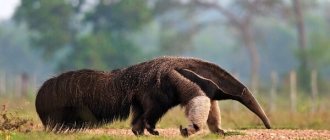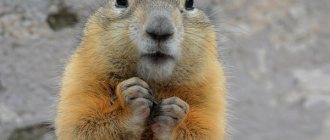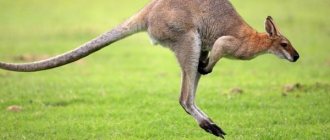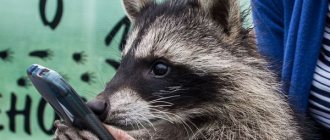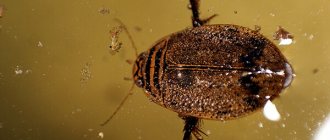Briefly about the scorpion squad
Because of their resemblance to crayfish, scorpions are sometimes called land crayfish. Indeed, the body of a scorpion is covered with chitin. Two large forelimbs end in impressively sized claws. Four pairs of running legs are attached to a wide anterior abdomen, and a long posterior abdomen, popularly called a tail, ends in a round formation with a needle-sharp spine at its end. It is in it that the poisonous gland of the animal is hidden. Scorpions have a pair of large and up to five pairs of small lateral eyes at the front end of the body.
The structure of scorpions. The picture is clickable and can be enlarged
The sizes of scorpions are different - from 2-3 cm to 15-25 cm. Their coloring is also different. Often there are species of scorpions that have a yellow or yellow-green color. the yellow-green scorpion lives in Southern Europe . In small animals the body sometimes appears translucent, in others it has thicker tones, even with a brownish tint. For example, the motley scorpion , as well as the black or thick-tailed one . Large tropical scorpions are dangerous to humans.
Black or thick-tailed scorpion (Androctonus). He has poor eyesight, however, this does not prevent him from hunting and feeding on large insects and small vertebrates.
The famous Russian scientist Academician Evgeniy Nikanorovich Pavlovsky, speaking about scorpions, thoughtfully said: “I wonder why over the millennia, when geographical conditions changed, entire classes and orders of animals died out, and scorpions not only remained similar to their distant ancestors, but also retained the same way of life same. It still remains a mystery."
Indeed, many land creatures have undergone significant metamorphoses, while scorpions have retained their original appearance. Why? There is only one answer: apparently, nature created them so perfect, endowing them with a sufficient margin of safety, that changing environmental conditions did not introduce anything into their external and internal structure. By the way, in the same regard, we can recall such animals as crocodiles and turtles, the appearance of which has also remained virtually unchanged compared to their ancient ancestors.
The most recognized is the theory of the origin of scorpions, created by the biologist-parasitologist Academician E. N. Pavlovsky and supplemented by A. A. Byalynitsky-Birulya. According to these scientists, during the Silurian period of the Earth's development, the scorpion belonged to the animals living in coastal sea waters. He became the ancestor of the terrestrial representatives of the order of scorpions. The first land scorpions appeared already in the Devonian period - more than 300 million years ago. All modern families of scorpions formed 70 - 100 million years ago.
The fact that scorpions have not changed under the influence of the environment for thousands of years is evidenced by the imprints of the bodies of ancient scorpions on stones. They are not much different from modern representatives. This ancient order of arthropods, oddly enough, has been little studied.
Currently, 77 genera and up to 700 species are known from the scorpion families, and in Russia and neighboring countries, 7 genera and a total of 12 species of these arachnid animals are distinguished from 2 families. Famous Caucasian species of scorpions are yellow, thick-tailed (or black), kolkhaz, and Abkhazian. There are 5 species of scorpions in the Caucasus, of which in Azerbaijan there are 3 species belonging to the same genus. There are over 80 species of scorpions in India.
The scorpion of the species Leiurus quinquestriatus is the most poisonous representative of the order. The color of the animal may vary depending on the habitat
Scorpions can be found at the foot of the mountains and high in the mountains - at an altitude of up to 2 thousand m above sea level, as well as in hollows, gorges, deserts, often rocky, where there are more insects and other food items. They can often be found in the most unusual places for them, especially in tropical regions.
In less warm areas, with the onset of cold weather, scorpions go into hibernation. Scorpions hibernate in deep, sometimes up to 4 m, cracks in rocks, under stones, and sometimes in human housing.
Scorpions are distributed mainly in areas with hot and warm climates. Most cases of human poisoning from the poison of these animals have been recorded in South and Central America, Mexico, North and South Africa, and the Middle East. In Brazil, for example, from 0.8 to 1.4% of injured adults die from scorpion bites, among schoolchildren - 3 - 5% of those bitten, and among young children, mortality from bites reaches 15 - 20%. These are quite high numbers.
Currently, the venom of scorpions, like spiders, is used in biochemistry, molecular biology, neurophysiology and other branches of science.
Scorpio is one of the oldest inhabitants of the Earth
Scorpions are descended from eurypterids, extinct arthropods that existed during the Paleozoic era, shared features with modern scorpions, but lived in water. This fact is considered a successful example of the evolutionary transition of animals from water to land.
Some scientists dispute this claim, citing cladistic analysis (one of the scientific methods of biological classification). Paleontologists are unanimous that scorpions have been around for at least 400 million years. This makes them one of the most ancient creatures living on our planet.
Scorpios – 300 million years unchanged
Scorpios are a true mystery of nature. Everything about them is surprising. They lived on Earth already 300 or 400 million years ago. Fossilized scorpions have been found in Sweden, Scotland and America. Their appearance dates back to the era of the most ancient animals ever found on our planet. What surprises naturalists most is that even now scorpions have remained exactly the same as they were in distant prehistoric times.
Other animal species arose, changed, or disappeared altogether; Scorpions, to this day, remain the same as they were born. We can say that nature, having created the scorpion, immediately achieved perfection; no modifications were required. A disgusting creature, but perfect, harmful, adapted to the harshest conditions, the scorpion remained outside of evolution. And only its small size prevented it from becoming a real monster.
Scorpions belong to invertebrate animals, the class of arachnids. About 500 species of scorpions are known, almost indistinguishable from each other. The head and thorax of a scorpion form one whole (cephalothorax), in front of the head there are two small hard claws, on the sides there are larger claws similar to salad spoons. They capture prey and transfer it to small pincers that shred the food. The scorpion has eight clawed legs, but it moves very slowly.
A strong shell protects the scorpion, like a shield. The tail ends in a long spike that constantly secretes a drop of poison. The scorpion's mouth is located on the abdomen. The scorpion is the only animal in the world that has mysterious organs on its abdomen. The researchers called them "combs" because of their resemblance to a comb. We are talking about two plates located perpendicular to each other, equipped with scales. Naturalists find it difficult to determine what purpose these “combs” serve. They are believed to act as ventilators necessary for breathing.
The scorpion has eight small holes on its abdomen, each of which is an exit from the lung sacs. If seven of them are clogged, the animal will not suffer, and only when all eight holes are closed will the scorpion die two hours later.
Scorpios have poor vision and hearing. He hears with his legs because he does not have ears or eardrums, but has thin hairs on his legs - “acoustic hairs”, which act as a hearing organ.
Scorpions live in desert areas with dry, hot climates and in the tropics. They love warmth, but avoid direct sunlight. Therefore, scorpions always hide under stones, in cracks in rocks and soil, under the bark of trees, in the desert they bury themselves in the sand and crawl out only at night.
In search of warmth, they penetrate human homes, climb into beds, under clothes, and hide in shoes. In general, they definitely strive for some kind of shelter. It is almost impossible to observe scorpions living in the wild because of their constant desire to hide and hide.
French scientist Henri Fabre conducted the following experiment: he placed several scorpions in a specially equipped glass cage. This glass palace, which he called the “Louvre for scorpions,” allowed him to make amazing observations. He saw an extraordinary sight, “which no one has ever seen before, at least among those who know how to observe.”
His exceptional patience was severely tested. Scorpions always acted only at night, and, in addition, they were distinguished by their extraordinary slowness. Thanks to his extraordinary persistence, Fabre was able to penetrate many of the secrets of the life of Scorpios.
First of all, he was surprised by the fact that from October to March the scorpions ate absolutely nothing. Fabre placed delicious food in front of them, but they only carelessly threw it away. And at the same time, they were by no means, like snails, in a state of hibernation; they retained the same size, mobility and were constantly ready to defeat the enemy with the tip of their hooked spike.
Only in mid-March does the scorpion begin to show signs of appetite, and sometimes you can see it gnawing on an insect.
Fabre noticed that scorpions never attack large prey. And this is probably only due to lack of appetite, because if a scorpion enters into battle, it always emerges victorious in battles with other insects, even larger than itself, in size and better armed.
One day Fabre observed an extremely interesting fight between a scorpion and a praying mantis. The praying mantis was able to defend itself for a long time thanks to the fact that it captured the scorpion’s tail, but when, exhausted, it let go of the tail, it was immediately defeated - an injection in the stomach took its life. Faced with a large and strong mole cricket, the scorpion instantly plunged its spike into the mole cricket’s shell, and the insect, struck with one blow, died. The fight with the scolopendra lasted four days, the scorpion pricked it from all sides and won.
Scorpios are unusually restrained in food. Fabre tried to feed his pets cabbage butterflies; The scorpions paid almost no attention to them; if they killed, they only ate the head.
Fabre, believing that butterflies were unusual food for scorpions - inhabitants of scorched deserts - began to give them locusts. The same thing happened again: the locust calmly walked along the scorpion’s back, and he threw it away with his tail. One experimental scorpion lived for nine months without any food at all. The small scorpions, placed in glasses under muslin, lived from October to June, completely deprived of food, and continued to remain as active as if they were well fed.
Even more amazing examples are known. One naturalist observed a Languedoc scorpion that lived 368 days without food; An Algerian scorpion lived without food for 14 months.
These facts are difficult to explain. Where does a scorpion, deprived of food, get its energy? But Scorpio, usually so abstinent in food, during the period of love is distinguished not only by gluttony, but also by cannibalism. Fabre has seen many times how a female scorpion calmly devours a male, and she almost always eats him completely.
This happens only during the mating season, in April - May, and the female always devours the male, never vice versa. (The male is easy to distinguish from the female by appearance: males are lighter in color and more skinny.)
Deaf, almost blind, abstinent in food, Scorpios are surprisingly tender in love. Their union is preceded by long “courtship” and joint walks. At first they come into contact “face to face” or “forehead to forehead”. This strange pose is, as it were, a declaration of love and the end of marriage.
After this, the male, carefully taking his girlfriend “by the fingers,” leads her for a walk. These peaceful walks last for hours, sometimes even days, the “Groom” and “bride” touch each other’s heads, the male caresses the female with his paws.
It is usually believed that the kiss was invented by a dove. Fabre claims that the predecessor of the dove in this was the scorpion. He observed habits between the scorpion and his “lady” that exactly reproduced a kiss. If during a walk he meets another, stronger male, he can take away and take away the “bride”.
After long walks, the search for a home begins. Here you can see how the couple crawls from one stone to another, holding on to the tentacles all the time. The male leads the procession, the female obediently follows him.
If he finds something suitable for housing, he is always the first to enter there, and the female waits patiently outside. Then the female crosses the threshold. Sometimes it happens that they immediately crawl out together - this means that the female did not approve of the choice of apartment. And the scorpions, holding each other, again set out in search of shelter. Suppose the male saw a shard or stone under which he could build a dwelling. He, without letting go of the “hand” of the “bride,” breaks a passage under the stone, levels the ground with his tail and disappears into the hole. On the surface, a paw sticks out of the hole, with which the male is still holding his girlfriend.
More than once Fabre witnessed clashes when obstinate females, clinging to the ground, stubbornly refused to cross the threshold of the house. But they rarely managed to free themselves.
Wondering at the tenacity of the male whose short novel ends so tragically, Fabre writes; "A strange world in which the victim forcefully drags the killer to the altar." Just as among praying mantises, the female scorpion after mating devours the male, unless he manages to hide. She hits him with one blow from the tip. The “combs” (a curious apparatus located under the abdomen) act, according to Fabre, like a “devilish machine” from which the unfortunate male cannot escape.
The widow immediately begins the feast, but, as is often the case with Scorpios, she has no appetite. Then she eats only the head of the male, and throws his body out to be eaten by the ants.
A female scorpion, expecting offspring, often eats small scorpions from other nests. The female gains some decency when she becomes a mother. She gives birth to from 25 to 40 babies.
Scorpions are ovoviviparous creatures. From the laid eggs, young scorpions hatch immediately or after a very short period of time, fully developed, similar to adults.
The mother helps the cubs get out of the egg. She carefully grabs, tears and then swallows the egg membrane, releasing the newborn. She does this with the same tenderness and dexterity as a sheep or a cat when they eat the embryonic membrane.
The female scorpion was probably the first creature on earth to perform these maternal duties. After all, in those days when scorpions appeared on earth, there were no viviparous animals yet. This once again speaks of the high perfection of the scorpion’s body: the incubation period of its embryo passes in the same way as in higher mammals, without any danger - in the womb of the mother.
As the mother frees the babies from the shells enveloping them, they, as if on a bridge, climb onto her back along the tentacles that she lowers to make it easier for them to climb.
The mother does not care at all about the nutrition of her babies - she does not feed them anything. When young scorpions grow up a little, they will independently go in search of prey and a warm, secluded place. Scorpions live for three to four years.
Claude Marly, translated from French.
PS What else are British scientists talking about: that the scientific study of scorpions is an extremely exciting activity for some zoologists, so much so that scientists for this purpose even make long trips (of course, having previously taken care of hotel receipts) to their habitats - usually this is North Africa, Asia.
Description and features
Scorpio is a predatory arachnid creature. He has 8 legs. One pair of limbs ends in claws. The segmented tail with a curved spike at the end gives it a recognizable appearance. All 1,750 known species are similar in appearance but vary in size. Length varies from 1.3 cm to 23 cm.
The body consists of two main parts (togmata): the head and abdominal sections. The abdominal part, in turn, consists of a wide anterior and caudal posterior parts. The back part consists of five elements. A segment is attached to the latter, which ends with a needle. The end of the needle has two outlets for the toxin. The scorpion in the photo always shows a curved tail with a needle.
The poison is generated by glands. They are surrounded by muscles, during the contraction of which the fluid produced by the glands flows through the ducts to the end of the needle, and from there into the victim’s body. The head part is the union of the head and chest, the so-called cephalothorax or Cephalothorax. The cephalothorax is covered with a chitinous membrane.
On the head there are eyes and a mouth. At the mouth there are chelicerae - food processes, they function like jaws. Behind them come the pedipalps - claws. This is followed by three pairs of limbs that enable the arachnid to move.
The eyes are located on the upper part of the cephalothorax. Scorpio is an animal that can have from one to six pairs of eyes. The most advantageous position is occupied by the two main eyes. They are called median and are located at the top of the cephalothorax. The rest play the role of additional eyes, located on the left and right sides of the front of the body.
The middle eyes are the most complex. They cannot provide a contrast image, but they are the most sensitive visual organs among arachnids. They are able to sense even minor light fluxes. This allows you to distinguish the contours of the surrounding world in the dark.
Love until the grave: 10 animals that die immediately after mating
Brood size depends on the variety and environmental factors, and can range from two to 100. Young people generally resemble their parents. Growth is achieved by periodic loss of exoskeleton (ecdysis). A scorpion's developmental progression is measured in instar stages (how many molts it has undergone). Scorpions typically molt between five and seven times before reaching maturity. Molting is produced by a split in the old exoskeleton, which occurs just below the edge of the scutellum (in front of the prosoma). Scorpio then emerges from this rift; The pedipalps and legs are first pulled out from the old exoskeleton, followed eventually by the metasoma. When it emerges, the scorpion's new exoskeleton is soft, and makes the scorpion very vulnerable in case of danger. The scorpion must constantly move while the new exoskeleton is strengthened. The process of strengthening is called sclerotization. The new exoskeleton does not fluoresce; as sclerotization occurs and fluorescence gradually returns.
The clinging walk of a scorpio couple is well documented. In most species, males will show strong vibration, and this results in higher mortality from predation by other animals.
Centruroides vittatus
showing chelicera massage. The female is on the left, and the male can be seen holding her pedipalps.
Female Heterometrus spinifer
carries its newborn offspring on its back.
Despite their bad reputation, scorpions exhibit a maternal instinct that is unusual among arachnids.
| © 2010-2018 Scorpionariy all rights reserved |
Kinds
When deciding what class of animals a scorpion belongs to, just look at the biological classifier. Scorpios form a troop. It is part of the class of arachnids, which, in turn, is subordinate to the phylum of arthropods.
The main families included in the order of scorpions:
1. Akravidae - a family in which there is one genus and one species (Akrav israchanani). Discovered in one of the caves in Israel. A distinctive feature is the complete degradation of the visual organs.
Cave scorpion Akravidae
2. Bothriuridae - a family containing 140 species of small scorpions. Only two species are found in Australia and South Africa. The rest live in South America.
Scorpion Bothriuridae
3. Buthidae - butids. There are 900 species included in this family. With the exception of Antarctica, they live on all continents. The sizes of these arthropods are average. Most have 2 cm. The largest reaches 12 cm.
Scorpio Buthidae
4. Caraboctonidae - 4 genera and 30 species of these scorpions are found in America. One of the species can grow up to 14 cm in length, lives quite a long time, and is often kept in home terrariums. This species is called Hadrurus arizonensis or Arizona hairy scorpion.
Scorpion Caraboctonidae
5. Chactidae - Hectid scorpions. 170 species from 11 genera are included in this family. Their homeland is Central America.
Scorpion Chactidae
6. Chaerilidae - this family includes one genus, Chaerilus, which includes 35 species, they live in the south and east of Asia.
Scorpion Chaerilidae
7. Euscorpiidae - a family containing 90 species. Distributed in both Americas and Asia. There is a species found in the south of England. This family also includes the Crimean scorpion (system name: Euscorpius tauricus). Scorpions in Russia are represented by this endemic species.
Scorpion Euscorpiidae
8. Hemiscorpiidae or Hemiscorpeides - 90 species are included in this family. Some are kept in captivity. This family includes Hemiscorpius lepturus, a scorpion dangerous to humans.
Scorpion Hemiscorpiidae
9. Ischnuridae - a small family. It includes only 4 types. Distributed in Central Asia, Vietnam and Laos.
Scorpion Ischnuridae
10. Iuridae – 2 genera, 8 species are included in this family. It is common in Greece, Syria, Turkey, and northern Iraq.
Scorpion Iuridae
11. Microcharmidae is a small family consisting of 2 genera and 15 species. Arachnids are small, from 1 to 2 cm. They live in Africa and Madagascar.
Scorpion Microcharmidae
12. Pseudochactidae is a family consisting of 4 species. Lives in caves in Central Asia and Vietnam.
Scorpion Pseudochactidae
13. Scorpionidae - 262 species, of which 2 are extinct, are included in this family and live everywhere except Europe and Antarctica. Some species are often kept at home. The emperor scorpion (system name: Pandinus imperator) is especially popular. It can grow up to 20 cm in length and reach a weight of 30 g.
Scorpionidae
14. Superstitioniidae - the family contains one genus. These are small (2-2.5 cm in length), yellow or yellow-brown scorpions found in Arizona.
Scorpion Superstitioniidae
15. Vaejovidae - the family includes 17 genera and 170 species. All species are native to Mexico and the southern United States.
Scorpion Vaejovidae
Speed of scorpions
Despite this seemingly awkward body structure, scorpions are very fast and resourceful. One of the biologists-araneologists interestingly describes the hunting of scorpions in Central Asia. Having discovered three scorpions at once, the size of which was the size of a matchbox and one of which was yellow-black in color, A. Nedyalkov pointed tweezers at one of them, but it quickly slid under the stone and was gone, followed by the second scorpion, then the third . After turning over several stones, we discovered several more scorpions. One of them was captured and put in a box. When they imprisoned the other one, the first one managed to jump out and ran along the sleeve of the araneologist’s shirt towards his head. The biologist threw down the box and began pounding on the sleeve with tweezers, trying to throw off the scorpion rushing forward. The movements of the araneologist were similar to the dance of a Papuan. Despite the critical situation, his comrades burst into laughter. Finally, the scorpion deftly jumped from the sleeve to the ground and was gone. His second relative also ran away from the opened box, and all this happened in a matter of minutes.
Lifestyle and habitat
It is believed that scorpions prefer hot, dry, desert and semi-desert areas. But the statement that the scorpion is a desert animal is not entirely true. In fact, they can be found in any territory that is not characterized by long, frosty winters. Although some representatives (for example, the Buthidae family) tolerate temperature drops of up to -25 °C.
Some species are not tied to a specific habitat. They can be found in forests, fields and even cities. For example, the Italian scorpion (Latin name: Euscorpius italicus) lives throughout Europe, in the South and North Caucasus. Others prefer only a specific niche.
Hygrophilic forms inhabit humid places, while xerophilic forms inhabit desert areas. Many exotic animal lovers keep scorpions at home. Organizing a place for this arachnid to live is simple. A rectangular glass terrarium will do.
Most often, lovers of these animals acquire the species Pandinus imperator. This scorpion lives in captivity for a long time, up to 10 years. It grows to large sizes, up to 20 cm. It is not for nothing that it is called imperial. What is important is that its poison has low toxicity.
Scorpio in the desert
The temperature and humidity in the terrarium are adjusted to the selected species. Emperor scorpions love high humidity and high temperatures (about 25 °C). Feed the scorpion once a week. 1-2 crickets or mealworms will completely satisfy the predator.
But the emperor scorpion is low-toxic. This makes it, in the eyes of amateurs, not a very interesting object to keep. In this case, exotic lovers choose the species Androctonus australis (aka: fat-tailed scorpions).
Every year they kill several dozen people. The conditions of their maintenance are as simple as those of imperial scorpions. Safety considerations come first. A killer Scorpio should not be able to escape.
What to do if you are stung by a scorpion?
For humans, a scorpion sting in most cases is not fatal; it mainly causes unpleasant sensations, accompanied by such manifestations as sharp pain, swelling and redness of the skin around the wound. However, the poison of some species of these animals can be fatal.
Since not each of us can identify which scorpion has bitten - dangerous or non-dangerous, it is necessary to immediately provide first aid. To do this, you need to try to squeeze out or suck out the poison.
Treat the wound with antiseptic drugs, apply cold or apply a tight bandage that can slow down the spread of the poison. Apply antiallergic drugs. After providing first aid, be sure to take the victim to the hospital.
Despite the fact that the scorpion is quite dangerous, people have been interested in it since ancient times. Nowadays, it is increasingly possible to see it in people's homes, and it is also the main attribute in magic and witchcraft.
Nutrition
The scorpion's food is, first of all, insects, spiders, and butterflies. Anything he can catch and anything that fits his size, including members of his own species. A lucky scorpion is able to kill and eat a small lizard or mouse.
In unfavorable conditions, scorpions can go without food for a long time. Many months of starvation of this arthropod have been recorded while maintaining normal activity. In the right case, a scorpion can eat a relative, that is, they are characterized by cannibalism.
The limbs of this arachnid are equipped with sensitive tactile hairs. They pick up vibrations in the soil caused by an insect that appears next to the scorpion. After which the unwary victim is captured. Focus on tactile senses makes Scorpio a successful night hunter.
Scorpion eats insect larvae
Scorpio does not always give a poisonous injection. Poison must be saved. It takes him a long time to recover. Therefore, small insects are killed by simply holding them and tearing them apart. Or they become food while still alive.
Scorpio cannot digest the hard parts of insects. It releases a certain amount of digestive juice onto the victim, and absorbs everything that turns into a semi-liquid state. Scorpio is a dangerous nocturnal predator.
But it is often itself a victim of other carnivores. The first place among scorpion hunters is occupied by scorpions themselves. Spiders, birds and small predators actively hunt these arthropods. Victory is ensured by weak susceptibility to poison. A quick attack from the rear is no less effective. Mongooses, hedgehogs and monkeys use this tactic.
Danger to humans
The insect's venom has neurotoxic properties. It constantly accumulates in the glands, so a bite can cause the most unpleasant consequences.
- Fortunately, there are two types of poison:
- Most scorpions are capable of paralyzing insects, but for a person the bite will pass without any special consequences - swelling, itching at the site of skin damage and moderate pain (as with a bee or wasp sting) may occur.
- The second type of poison affects primarily mammals. In humans, such poison can cause paralysis of the nervous system, which will lead to disturbances in the functioning of the heart and lungs. Vomiting and increased salivation occur. Without the introduction of an antidote, death is possible. This poisonous bite is especially dangerous for young children.
Severe intoxication in humans is caused by the poison of 25 species of scorpions out of 50, which have the ability to paralyze a mammal.
The easiest way to determine the poisonousness of an insect by eye is to visually compare the proportions of its body. Dangerous species have rather small limbs and a powerful abdomen with a large needle. Species that are not dangerous to humans have impressive claws, but have a small sting. A fatal bite can be obtained from Androctonus, native to the Middle East and Africa. This species is also called the “man-killer.” Scorpio has a black body color and reaches a length of 10 centimeters. Several deaths caused by the sting of the Androctonus scorpion are reported each year.
This species is considered the most dangerous to humans in the world. Pharmaceutical companies produce an antidote to relieve intoxication caused by the venom of this scorpion. In total, there are 18 species of Androctonus from the butid family in the world. These include the extremely poisonous Androctonus amoreuxi and Androctonus australis. Androctonus amoreuxi is found in Africa and Asia. The scorpion is colored light yellow and often hides in sand dunes. Sightings with this species were also recorded in Uzbekistan. Androctonus australis is also a native of Africa and Asian regions. The color of the insect is sandy, body length is up to 12 centimeters. In addition to insects, the scorpion feeds on small rodents.
Reproduction and lifespan
The mating ritual includes mating and a mating dance. The male holds the female with his forelimbs and begins to lead her along. This joint movement can continue for hours.
During this strange round dance, the male releases a capsule with seminal fluid (spermatophore). The female, following the male, comes into contact with the spermatophore. It enters the female's genitals, located in the lower abdomen. Fertilization occurs.
Female scorpion with offspring
The end of the mating dance coincides with the end of the fertilization process. At this moment, it is important for the male to quickly leave, otherwise he will be eaten. The female's pregnancy lasts a long time: from several months to one and a half years. As a result, from 20 to 30 or more cubs are born. The newborns are born one by one and are placed on the mother's back.
The scorpion is an invertebrate animal , but it has an exoskeleton in the form of a shell. In newly born arthropods it is soft. After a few hours the shell hardens. Young scorpions leave their mother's back and begin to lead an independent life. The first threat that they encounter in their life is their own mother. She can eat her offspring.
One of the important stages in the life of a Scorpio is molting. The age of young arthropods is measured by the number of molts. In order to become adults, young scorpions need to survive 5-7 molts.
The exoskeleton splits, the scorpion crawls out of the old shell, remaining soft and defenseless until the new armor completely hardens. Scorpions live long. From 2 to 10 years. Under favorable conditions, this life threshold can be exceeded.
Reproduction of scorpions: mating games
The male, ready for mating, goes out at night in search of a “bride,” leaving behind an odorous trail of a substance that attracts the female (sexual attractant). The scorpio groom himself senses the bride's trace using the hairs on the thin, comb-like tactile organs at the bottom of the body. Having finally met a female, he begins an unusual mating game. The scorpion quickly approaches the female, while drumming on the ground with its pedipalps. The raised sting signals readiness for mating. Such a game is necessary so that the female can distinguish the male from potential prey. But if the insidious bride is hungry or not ready to mate, then, without much ceremony, she can attack the would-be groom and eat him.
Where does the imperial scorpion live?
Photo: Black Imperial Scorpion
The emperor scorpion is an African species native to tropical rain forests, but is also present in the savanna, in close proximity to termite mounds.
Its location has been recorded in a number of African countries, including:
- Benin (small population in the western part of the country);
- Burkana Faso (very common, almost everywhere);
- Ivory Coast (quite common, especially in hard-to-reach areas);
- Gambia (is far from being in the first positions among the Scorpio representatives of this country);
- Ghana (most individuals are located in the western part of the country);
- Guinea (widespread);
- Guinea-Bissau (found in small quantities);
- Togo (revered by local residents as a deity);
- Liberia (found in the wet shrouds of the western and central parts);
- Mali (the emperor scorpion population is widespread throughout most of the country);
- Nigeria (a common species among representatives of the local fauna);
- Senegal (small numbers present);
- Sierra Leone (large colonies are observed in the eastern tropical forests);
- Cameroon (quite common among fauna).
The emperor scorpion lives in deep underground tunnels, under rocks, broken branches and other forest debris, and in termite mounds. Pectins are sensory organs that help determine the area where they are located. The species prefers relative humidity of 70-80%. The most comfortable daytime temperature for them is 26-28 °C, and at night from 20 to 25 °C.
If a scorpio came to people
Scorpions are not pests in the conventional sense. But being close to them can bring unpleasant consequences. There are two options for how to protect your family from encountering a scorpion: kill it, isolate it, or secure your home.
- Order on the site, the absence of holes and cracks in buildings is a good preventive measure.
- Isolate Scorpio. You can try to catch the animal using special devices or manually, but trying to protect yourself.
- Kill. You will need a sharp stick, a heavy object or chemicals.
- In areas where encounters are frequent, shoes and clothing should be checked.
Main differences from insects
As you know, insects have 3 pairs of legs. All chelicerates have 4 pairs of walking legs, so you can distinguish representatives from each other even with the naked eye. There are no insects with more than six legs.
Another difference is the presence of chelicerae, which give this subtype its name. This word refers to oral appendages designed to capture food.
But the claws, which in scientific language are called pedipalps, deserve the most attention. Something similar exists in cancer, which is also an arthropod and is related to the scorpion. But none of the insects have.
Count the limbs and everything will become clear. It is not so difficult to find the answer to the question of whether a scorpion is an animal or an insect.
The photo shows the structure of a scorpion. You can see:
- head with eyes and chelicerae;
- 4 pairs of walking limbs and a pair of pedipalps attached to the cephalothorax segments;
- segmented abdomen;
- telson (anal part), above which the poison gland is located.
Keeping scorpions in captivity
Maybe you have thought about such a pet? Is this why you are wondering what a scorpion is - is it an animal or an insect?
The description of these creatures has long allowed many breeders to decide to place a scorpion in their homes. Many species are perfect for keeping in a terrarium. Such an amazing pet will certainly impress friends and glorify the owner as an extraordinary and courageous person.
Scorpions should not be overfed; they need food no more than once every 3 days. The diet should be similar to what scorpions have in nature. The menu should include insects, spiders, worms, and larvae. Large species are also suitable for feeding rodents. Free access to the drinking bowl and moistening from a spray bottle are required. Scorpios are not very sociable, but they get used to a good-natured and attentive owner quite quickly.
Close relatives
Let's talk to those whose gender affiliation also causes confusion. First of all, these are spiders and ticks. It is worth remembering that they also belong to the phylum arthropods and the class of arachnids.
It is appropriate to mention some more unusual creatures that are mistakenly classified as scorpions.
The order received its name due to its pedipalps ending in claws. As we can see from the photo, they do not have a tail with a poisonous sting. In fact, these creatures are spiders. False scorpions, like ordinary scorpions, are animals, not insects. They are very common on the planet, but they lead a secretive lifestyle and have modest sizes (up to 1.2 cm), so many people do not even know about their existence. But if you happen to pay attention to such a baby, you will know that this is not a desert cub, but an adult creature. It cannot sting and does not pose any danger.
